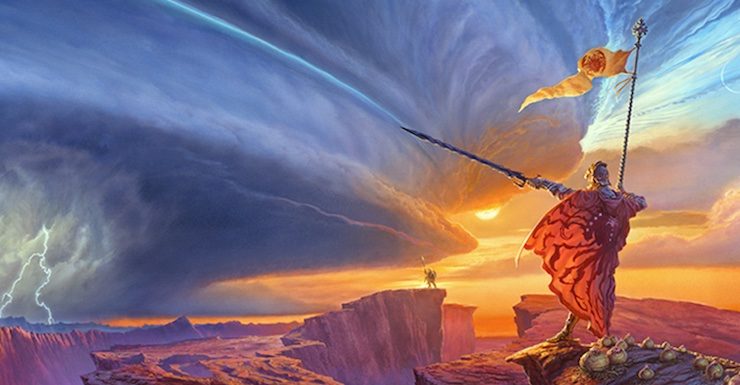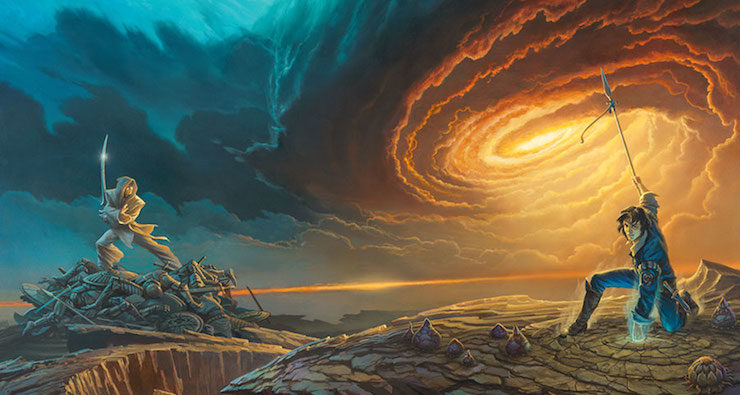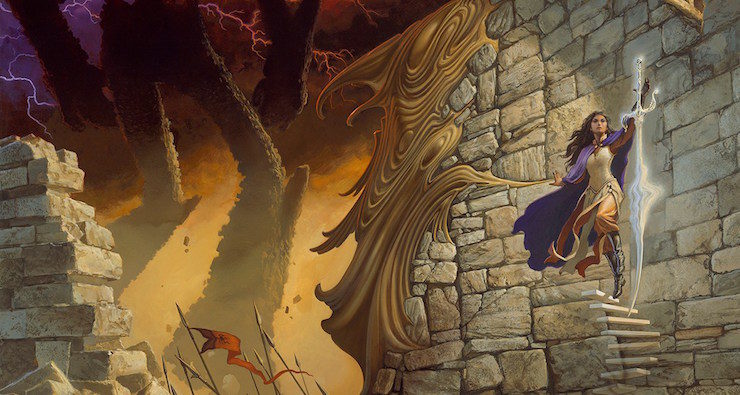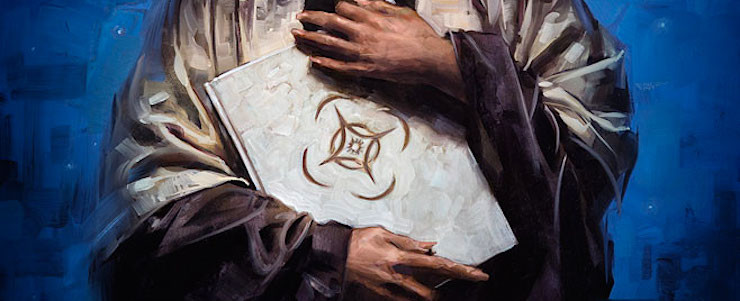The Cosmere of Brandon Sanderson is a huge, overarching concept driving the narrative structure of his work, and while it may seem fairly straightforward on the surface, the deeper ramifications of these connections are going to be felt all across his books, especially going forward with the rest of his series.
So! Let’s get started. First question: What the heck is a Cosmere?
The origin of the Cosmere goes something like this: a long, long time ago, there was a singular entity that went by the name/title of Adonalsium. From what little we know, it was a celebrated force of life and creation. But something happened and Adonalsium was shattered into sixteen shards, each of them containing a single aspect of Adonalsium’s cosmological DNA and power, with both positive and negative aspects contained within.
Present at the Shattering of Adonalsium were sixteen individuals, who found the Shards left from the catastrophe and took them up, gaining immense power, and essentially ascending to godhood. With this newfound power, the Shardholders went off to do whatever it is that gods do.
With a consciousness to direct them, many of the Shards began to Invest their magic and influence in certain planets or peoples. Every Shard impacts a planet in a way that allows certain individuals to tap into its own distinct magical power. Sometimes that magic is Invested in the environment, as is the case with the Tears of Edgli in Warbreaker or the highstorms that come roaring through Roshar in The Stormlight Archive series; other times, the power is actually present within the individual, and they simply need fuel to activate it (i.e. burning metal in Mistborn).
The Cosmere is Sanderson’s fictional universe, far larger than just a planet or two; it encompasses solar systems and even galaxies. It’s entirely set apart from Earth, so any books or stories Sanderson sets on any version of Earth, (his Reckoners series, the Rithmatist series, etc.), have nothing to do with the Cosmere.
On a purely cosmological level, this setting is a huge playground, full of potential, where characters from different books can, have, and will end up meeting and interacting with each other across the stars. All of the Cosmere books are set amidst the various planets and systems and galaxies, and through various methods, there have already been some interplanetary crossover between certain characters. As Sanderson continues this epic story, those connections are only going to increase, leading to some interesting results.
On a slightly more abstract note, it’s also important to note that there are three different realms of existence in the Cosmere: the Physical Realm, the Cognitive Realm, and the Spiritual Realm. All things possess an aspect in each realm; Physical is the world you stand on now, Cognitive is the realm of thought and intentionality, and may be a method to allow travel between planets (accounting for some of the aforementioned inter-narrative meet-ups), and Spiritual has only been hinted at, but it seems to be, of course, some sort of afterlife. Not much is known about these realms currently, but as Sanderson’s characters learn more and more, they could hold the key to some very interesting opportunities.
So, we have various god-like beings tinkering around with the fundamental forces of the Cosmere for their own ends and curiosities. That all sounds well and good, except there is a caveat, as there always must be: the longer a person holds a Shard, the more that Shard’s influence comes to bear. The person who holds the Shard of Ruin was said to be a good man before taking it up, but after so many millennia, he literally became Ruin, the singular aspect of it driving him to assume the full mantle of destruction, cruelty, and pain. So while this influence is welcome in such Shards as Preservation, Honor, and Cultivation, it can lead to disastrous results in Shards that exert a more negative or destructive influence.

Whoa, that sounds intriguing. But this is a lot of information. What’s the actual story here?
Ah, you’re right! To pick up the story so far: when Adonalsium was shattered, and broke into sixteen Shards, the sixteen people present at the Shattering took up these Shards, one each, and found their way to different planets. They then set about doing what they felt compelled to do: make life, tinker with magic, and explore their new abilities.
Except, remember that caveat above, about how the longer a person holds their Shard, the more the Shard starts to override their personality, until they’re essentially transformed into that Shard? Well, then let me introduce you to a charming fellow by the name of Odium, whose Shard is basically an overwhelming hatred and disgust of pretty much everyone and everything. Consumed by the intense hatred of his Shard, Odium decided that there could be no other Shards, and instead of taking them for himself (which would change his personality and the influence of his own Shard), he simply decided to destroy the others.
I’ll not recount all the details for fear of spoilers, but needless to say, Odium has been somewhat successful in his relentless hatred and pursuit of war in the Cosmere. While not much is known about him, he has only just begun to rear his hateful head in The Stormlight Archive, and I can only assume we’ll get to know him as he was before taking up his Shard, as well as his motivations and his fall, as the story of the Cosmere coalesces.
But wait! Before you think all is lost against this enormous, cosmic force of hatred, you should know that hope prevails. There’s someone out there who understands what’s going on, and is actively working against Odium: a strange, witty, beguiling, and powerful man by the name of Hoid.
Appearing in incredibly subtle roles throughout Sanderson’s earlier books, Hoid is slowly coming into the spotlight of the Cosmere. Not much is known about him, except that he can travel from planet to planet, has potentially more than one magic system he can Invest into, and is extremely old—he was at the Shattering of Adonalsium, though he holds no Shard. He knows what’s really going on in the Cosmere as well as the stakes involved, and is endeavoring to recruit the remaining Shards and Worldhoppers (other powerful magic users like him who can traverse between Shardworlds) to help him stop Odium. What his endgame is, though, no one is quite sure.

Dang, that sounds intense. So what else do I need to know in order to read these awesome books?
Well, I wrote about this earlier, but when it comes to the Cosmere stuff? Don’t worry about it too much. Sanderson wrote all of this into the deep bones of his stories, and for the novels that are out now, you honestly don’t need a working knowledge of the Cosmere.
As you progress, you’ll start seeing the clues and start learning more about it, but don’t feel like you can’t enjoy the books on their own merits, without scouring them for deeper meanings and connections. Sanderson specifically writes his novels to be accessible, and while someday in the future readers will need to have a greater awareness of and familiarity with the Cosmere, we haven’t reached that point quite yet!

So what happens next?
Well, who knows? (Except for Sanderson!) We, the readers, don’t know a whole lot for sure, but there are a bunch of great forums and websites and wikis that are working hard to piece together the clues we have, and there are some fascinating theories and brilliant bits of speculation to delve into as we await further books set in the Cosmere.
What we do know is that Odium continues to wage war against the rest of the Shards, Hoid is (seemingly) out to stop him, and in between we have other Shards, Worldhoppers, and magic users from every planet in Sanderson’s work who have been or will be affected in some way, and will ultimately have to pick a side: will they stand against Odium and his all-consuming hatred, or will some recognize themselves in him, and join his devastating war against life?
Only time, and Brandon Sanderson, will tell.
Top image by K R Hart.
This article was originally published in July 2015
Martin Cahill is a publicist by day, a bartender by night, and a writer in between. When he’s not slinging words at Tor.com, he’s contributing to Book Riot, Strange Horizons, and blogging at his own website when the mood strikes him. A proud graduate of the Clarion Writers’ Workshop 2014, you can find him on Twitter @McflyCahill90; tweet him about how barrel-aging beers are kick-ass, tips on how to properly mourn Parks and Rec, and if you have any idea on what he should read next, and you’ll be sure to become fast friends.











Very good read, except that you may want to clarify: the spiritual realm is NOT the same as the Beyond, which is the afterlife. We don’t know much about the spiritual realm except that it seems to exist outside space and time.
I wouldn’t use the term “cruelty” for Ruin. Destruction and decay, yes.
Head hurts… I managed to master Tolkien’s legendarium over a span of years. I’m not sure I have enough synapses left to process this one.
No that I mind all the reposts, but is this because y’all at Comic-Con?
@2:
Especially considering Ruin’s original Shard-name was Decay.
@1:
We also know that the Spiritual Realm is normally where a Shard’s power resides.
The influence of the more positive Shards like Preservation can be problematic as well. The ideal of Preservation is that of pinned butterflies, preserved under glass. If it had free reign, the world under its influence may have turned static and unchanging.
@7 – I agree. Remember in Mistborn: Secret history (white out for spoilers) Fuzz is enraptured by the Lord Ruler because he’s perfectly preserved himself.
@7,8:
You’re dying from the moment you’re born. Growth and change is about death. I’m not sure I buy Preservation and Ruin combining to form Harmony, though. I think there’s more to the concept of harmony than those two things.
Also note that the Cosmere doesn’t span galaxies, but a single, compact dwarf galaxy.
@9
Harmony can encompass any number of of ideas, Chaos and Order, Good and Evil, Life and Death, etc. And I think it’s the proper name for someone who now holds Ruin and Preservation (the only other one I could think of is Balance). I’m not sure it is any more complex than that in this instance.
Very good article!
You know you’re into cosmere too much, when you found three points you don’t agree:
– Spiritual Realm is probably not the afterlife – souls naturally pass to the Beyond which is their “afterlife”, Spiritual Realm is bound to reality of living, and is thought to be a place of Connection, spirit, essence and truth (objective)
– From what i remember, Odium started hunting other Shardholders very soon after Shattering and picked this Shard because it suited his needs
– Odium goal seems to be – “let’s become the most powerful being in the universe” than “let’s kill everybody else” He kills different Shardholders because they can oppose him, but it’s not like life on, for example Sel was vanquished completely. IDK, maybe i just wanna see Odium as less one-sided character, I would love if he has more reasons to act as he acts.
Pretty good article though, i just couldn’t hold it. If I am wrong, please correct me
Other commenters before has already pointed out some of the stuff.
Let me add some more: nothing we know confirms Tears of Edgli are Invested.
Since you were going with the whole “on Roshar storms are Invested, on Scadrial people are” thing you may add that on Nalthis it’s also people – Breaths are Investiture.
By the way, as far as Roshar is concerned, it’s not only highstorms that contain Investiture; spren are living Investiture and should be also be mentioned.
“other times, the power is actually present within the individual, and they simply need fuel to activate it (i.e. burning metal in Mistborn).”
this bit is wrong. Burning metals does not use your Investiture – it allows to channel Investiture from Preservation.
What else? Brandon has said that no Shard is really good or evil.
“There’s someone out there who understands what’s going on, and is actively working against Odium: a strange, witty, beguiling, and powerful man by the name of Hoid.”
We do not know what Hoid’s goals are. Yes, it seems he’s against Odium.
“[Hoid] is endeavoring to recruit the remaining Shards and Worldhoppers (other powerful magic users like him who can traverse between Shardworlds) to help him stop Odium.”
So far he recruited no Shard and no person we know of. (BTW worldhoppers do not have to be powerful magic users, they don’t even need to be magic users.)
Instead the worldhopping organization known as Seventeenth Shard is trying to hunt him down. Then there is Silverlight and some other worldhopping organizations and some more individual worldhoppers. Their goals are multitude.
As far as Odium is concerned, what we know of his goals is that he wants to be the most powerful being in Cosmere; since he doesn’t want to pick up other Shards, as it would change him, he kills them and Splinters them. However he does not seem concerned with lesser beings – after dealing with Selish Shards he did not wipe out humans or do anything to the planet.
This would be wonderful. I am new to Brandon Sanderson. I can’t wait to get lost in his universe. Everyone who knows I love fantasy tell me i have to read his books.
That’s some major league world building. I didn’t particularly like the Mistborn series after no 3, but loved the siren magic from Stormlight. Waiting to see how Brandon weaves this together.
Thanks so much for this article. I’ve never read Sanderson before but I have become familiar with his fanbase and with him as an author over the past two years via youtube. I feel like after reading this article I can really appreciate Sanderson’s works for what I want to believe them to be; works of genius.
Its worth pointing out this article is more than two years old, and some of that stuff regarding the Spiritual Realm wasn’t confirmed yet when the article was written.
It should probably be updated prior to reposting it again in the future, though.
I would agree that cruelty/pain don’t exactly fit Ruin (maybe Odium though). And likewise, I don’t view Odium as wanting to be the only shard/force on earth – annihilation does not seem to be his goal (again, that’s probably Ruin). But then again, we already had a Shard called Domination and Odium is clearly more than that. So maybe Odium does have some desctruive and perhaps even self hating tendencies.
There’s a thing that I remember someone saying about Darth Vader once, can’t remember if it was in a book or just someone posting something on the internet. “All that hate he has for everyone else, there’s still no one he hates more than himself.”
I’m pretty sure Odium is in a similar situation.
Hoid is mysterious, awesomely snarky, terrifyingly powerful, seemingly bound by strange rules, and MAYBE a good guy. He seems to be opposed to Odium, but his motivations for that are still unknown. He gives out needed advice in full-on Trickster Mentor fashion to main characters, and legends say he can’t harm a human directly (one gets the feeling that said legends might be as accurate as facts about The Stig on Top Gear, though). He hung out with the Shardholders while Adonalsium was still around, has no problem with the idea of goading a horrible, HORRIBLE person into killing him when he’s in a job where killing him would only carry the penalty of the perpetrator being stripped of all their lands and titles, and laughs off being threatened with a Shardblade. He’s also demonstrably NOT infallible.
The organization that’s hunting him is even more mysterious than he is at this point, and may be looking to force him into working for them so they can get him doing what they think he needs to do at a given time, stop whatever he’s doing (either because they understand more than we do about his motives and endgame, or out of a “this guy causes chaos wherever he goes, lets stop him from doing that!” kind of thing), or just get some payback for him being smug and annoying.